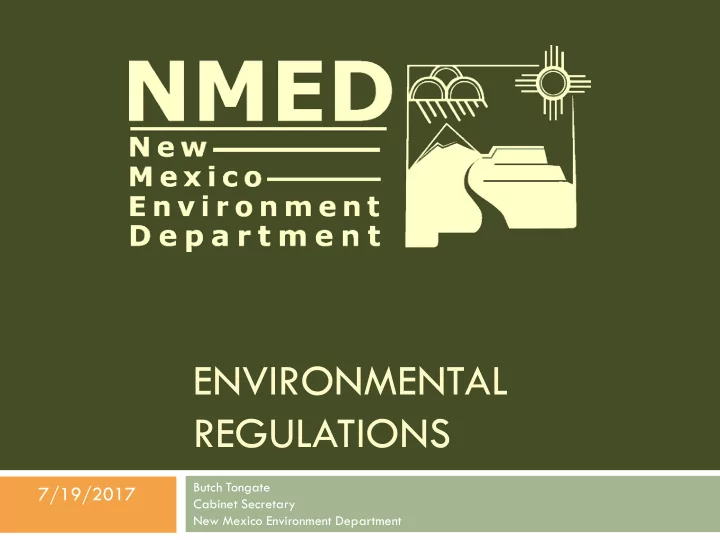

ENVIRONMENTAL REGULATIONS Butch Tongate 7/19/2017 Cabinet Secretary New Mexico Environment Department
Power Plants - Federal and State Regulatory Authority 2 Facilities, such as power plants, that emit regulated air pollutants in New Mexico are regulated by both the federal government and the state. Federal regulation is authorized by the Clean Air Act (CAA, 42 USC 85). State regulation is authorized by the New Mexico Air Quality Control Act (74-2 NMSA 1978). Bernalillo County has its own program based on state and federal statutes.
Power Plants – State Regulatory Authority 3 Power plant facilities that impound water (lagoons) and/or discharge to groundwater must also apply for a Discharge Permit (DP) under the Water Quality Act (WQA) (74-6-1NMSA 1978). State regulation (20.6.2 NMAC) is authorized by the WQA – NMED’s Ground Water Quality Bureau issues these permits. Ten of the 21 power generation facilities have DPs.
Groundwater Discharge Permits 4 Water used at power generation plants often contains elevated concentrations of: Chlorides Nitrogen Fluoride Sulfate Total Dissolved Solids (TDS)
Groundwater Discharge Permits 5 Regulatory requirements generally include: Lagoon construction approval Monitoring well construction approval Quarterly/Semi-Annual/Annual Sampling Submission of groundwater flow characteristics (quality, direction, and how fast it’s moving) on a potentiometric surface map
State Statute and Regulations 6 Section 74-2-7 of the state act requires applicants to obtain an air permit prior to construction. The state act authorizes the following permitting regulations: Construction Permits (20.2.72 NMAC) Operating Permits (20.2.70 NMAC) Prevention of Significant Deterioration (PSD) Permits (20.2.74 NMAC)
State Construction Permit Requirements 7 20.2.72 NMAC requires a construction permit when the potential emission rate of any regulated pollutant is greater than ten pounds per hour or 25 tons per year. Regulated air pollutants include: Nitrogen oxides (NOx) Carbon monoxide (CO) Sulfur dioxide (SO 2 ) Particulate Matter (PM) Volatile Organic Compounds (VOCs) Hazardous Air Pollutants (HAPs) HAPs include toxic air pollutants and heavy metals.
State Construction Permit Requirements 8 Air pollutant concentrations outside the facility fence line must be predicted through the use of air dispersion modeling. If the modeled concentrations are below the thresholds required by the National Ambient Air Quality Standards (NAAQS) and the New Mexico Ambient Air Quality Standards (NMAAQS), the permit will be issued for the facility.
State Construction Permit Requirements 9 If modeled concentrations outside the fence line are not below the thresholds required by the NAAQS and the NMAAQS, then either: The facility must install controls to lower pollutant emissions, so that modeled concentrations at the fence line will meet the thresholds required by the NAAQS and the NMAAQS; or The permit will be denied.
New Mexico Power Plants 10 New Mexico regulates 21 electric power plants. Two power plants burn coal in boilers. Most power plants in New Mexico are natural gas fired turbines. Some small plants use reciprocating engines.
Power Plants and Federal Regulations 11 Power plants in New Mexico are subject to federal regulations promulgated under the authority of the Clean Air Act (CAA). New Source Performance Standards (NSPS, 40 CFR 60) were promulgated under Section 111. National Emissions Standards for Hazardous Air Pollutants (MACT, 40 CFR 63) were promulgated under Section 112. Clean Power Plan – Supreme Court stay in effect as of Feb 2016, stopping all work on this rule.
New Mexico Power Plant Emissions 12 New Source Performance Standards (NSPS) and Maximum Achievable Control Technology (MACT) regulations impose requirements that usually require pollution controls on power plants. Control devices may be required also by modeling or by state regulations. Common control devices include: Catalytic converters to control NOx and CO Fabric filters to control PM And scrubbers to control SO 2
PNM - San Juan Generating Station 13 Additional Requirements for power plants exist under the CAA’s Regional Haze Rule. Only one NM facility was subject to this regulation, which required Best Available Retrofit Technology (BART) on the San Juan Generating Station (SJGS). BART requirements for SJGS included installing pollution controls on Units 1 and 4 and retirement of Units 2 and 3. These BART requirements were negotiated between US EPA, PNM, and NMED.
Federal and State Regulations 14 SJGS has the following control devices installed to reduce air emissions: Fabric Filters and activated carbon injection to control particulate matter and mercury Selective Non-Catalytic Reduction (SNCR) to control NOx emissions Scrubbers to control SO 2
PNM - San Juan Generating Station Raton Generation Project Williams Four Corners - Municipal Electric System - Milagro Gas Treating Plant Electric Power Plant Animas Power Plant Farmington Electric Utility Systems - Bluffview Power Plan t Prewitt Escalante SPS - Quay County Generating Plant Generating Sta tion La Luz Energy Center Valencia Power Plant Lea County Electric Cooperative Power Plant Lordsburg Generating Station Lea Power Partners - Xcel Energy - Cunningham Statio n Hobbs Generating Station Southwestern Public Service Co. Maddox Station Pyramid Generating Station El Paso Electric Carlsbad Power Station Rio Grande Generating Station Afton Generating Stat ion Four Peaks Energy Plant No1 Luna Energy Facility
Recommend
More recommend